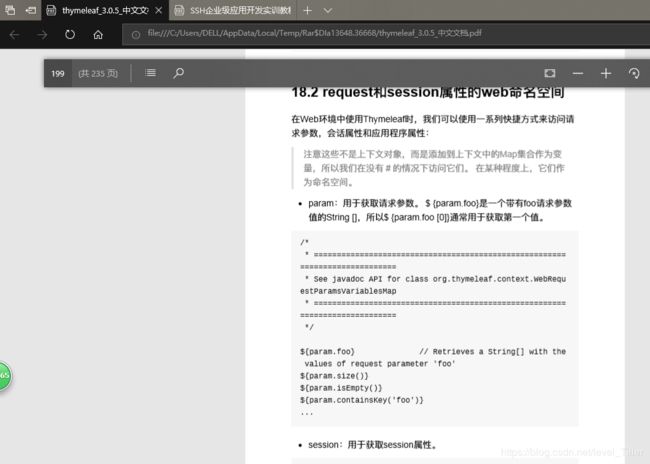springboot之thymeleaf模板引擎
模板引擎:jsp,velocity,freemarker,thymeleaf
1、引入thymeleaf
添加依赖
org.springframework.boot
spring-boot-starter-thymeleaf
切换thymeleaf版本
2、thymeleaf语法
@ConfigurationProperties(prefix = "spring.thymeleaf")
public class ThymeleafProperties {
private static final Charset DEFAULT_ENCODING = StandardCharsets.UTF_8;
public static final String DEFAULT_PREFIX = "classpath:/templates/";
public static final String DEFAULT_SUFFIX = ".html";只要我们把html页面放在classpath:/templates/,thymeleaf就能自动渲染
测试;
controller里
package com.cnstrong.springboot04webrestfulcrud.controller;
import org.springframework.stereotype.Controller;
import org.springframework.web.bind.annotation.RequestMapping;
import org.springframework.web.bind.annotation.ResponseBody;
@Controller
public class HelloController {
@ResponseBody
@RequestMapping("/hello")
public String hello(){
return "Hello world";
}
@RequestMapping("/success")
public String success(){
//classpath:/templates/success.html
return "success";
}
}
resources/templates下编写success.html
Title
成功
3、使用
导入thymeleaf的名称空间
HelloController中
//查出一些数据,在页面显示
@RequestMapping("/success")
public String success(Map map){
//classpath:/templates/success.html
map.put("hello","你好");
return "success";
} resources/templates/success.html中
Title
成功
这里是显示欢迎信息
运行
4、语法规则
th:text 改变当前元素里面的文本内容
th:任意html属性 替换原生属性的值
能写什么表达式?
简单表达式:
变量表达式:$ {...} 获取变量值 OGNL
可以使用获取对象的属性、调用方法
使用内置的基本对象
#ctx:上下⽂对象。
#vars:上下⽂变量。
#locale:上下⽂区域设置。
#request :(仅在Web Contexts中)HttpServletRequest对象。
#response:(仅在Web上下⽂中)HttpServletResponse对象。
#session :(仅在Web上下⽂中)HttpSession对象。
#servletContext :(仅在Web上下⽂中)ServletContext对象。
详细用法参见手册附录A
#execInfo:有关正在处理的模板的信息。
#messages:⽤于在变量表达式中获取外部化消息的⽅法,与使⽤# {...}语法获得的⽅式相同。
#uris:转义URL / URI部分的⽅法
#conversions:执⾏配置的转换服务(如果有的话)的⽅法。
#dates:java.util.Date对象的⽅法:格式化,组件提取等
#calendars:类似于#dates,但对于java.util.Calendar对象。
#numbers:⽤于格式化数字对象的⽅法。
#strings:String对象的⽅法:contains,startsWith,prepending / appending等
#objects:⼀般对象的⽅法。
#bools:布尔评估的⽅法。
#arrays:数组的⽅法。
#lists:列表的⽅法。
#sets:集合的⽅法。
#maps:地图⽅法。
#aggregates:在数组或集合上创建聚合的⽅法。
#ids:处理可能重复的id属性的⽅法(例如,作为迭代的结果)。
详细用法参见附录B
这两种⽅式有⼀个重要的区别:星号语法计算所选对象⽽不是整个上下⽂ 的表达式。也就是说,只要没有选定的对象,$和*语法就会完全相同。
什么是选定对象? 使⽤th:object属性的表达式的结果。
我们在⽤户个⼈ 资料(userprofile.html)⻚⾯中使⽤⼀个:
Name:
Surname:
Nationality:
这完全等同于:
Name:
Surname:
Nationality:
消息表达式:#{...}
链接⽹址表达式:@{...} 定义url
如果需要⼏个参数,这些参数将以逗号分隔:@ {/ order / process(execId = $ {execId},execType ='FAST')}
⽚段表达式:〜{...}
⽂字
⽂字⽂字: 'one text' , 'Another one!'
数字字⾯值:0,34,3.0,12.3,...
布尔⽂字:true,false
空字⾯值:null
⽂字Token:one,sometext,main,...
⽂本操作
字符串连接:+
⽂本替换:|The name is ${name}|
算术运算符
⼆进制运算符:+,-,\*,/,%
负号(⼀元运算符):
布尔运算符
⼆进制运算符:and 、or
布尔否定(⼀元运算符):!,not
⽐较和相等运算符:
⽐较运算符:>,<,> =,<=(gt,lt,ge,le)
相等运算符:==,!=(eq,ne)
条件运算符:
If-then:\(if\) ? \(then\)
If-then-else:\(if\) ? \(then\) : \(else\)
Default:\(value\) ?: \(defaultvalue\)
特殊符号:
哑操作符:\_
所有这些功能可以组合和嵌套:
'User is of type ' + (${user.isAdmin()} ? 'Administrator' : (${user.type} ?: 'Unknown'))
5、测试
HelloController中
//查出一些数据,在页面显示
@RequestMapping("/success")
public String success(Map map){
//classpath:/templates/success.html
map.put("hello","你好
");
map.put("users", Arrays.asList("zhangsan","lisi","wangwu"));
return "success";
}
success.html
Title
成功
这里是显示欢迎信息
[[${user}]]
虽然[[...]]等价于th:text(即结果将被HTML转义),[(...)]等价于 th:utext,不会执⾏任何HTML转义。



















